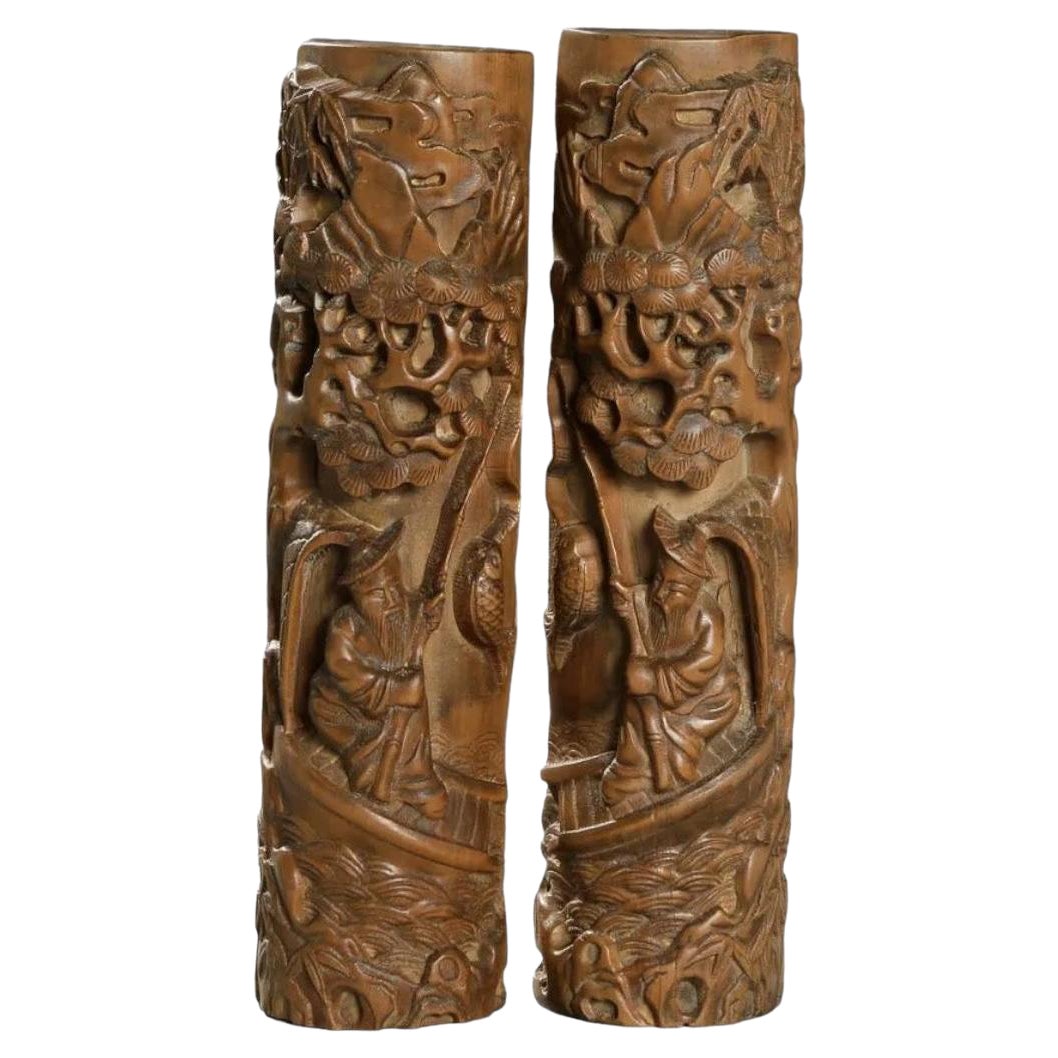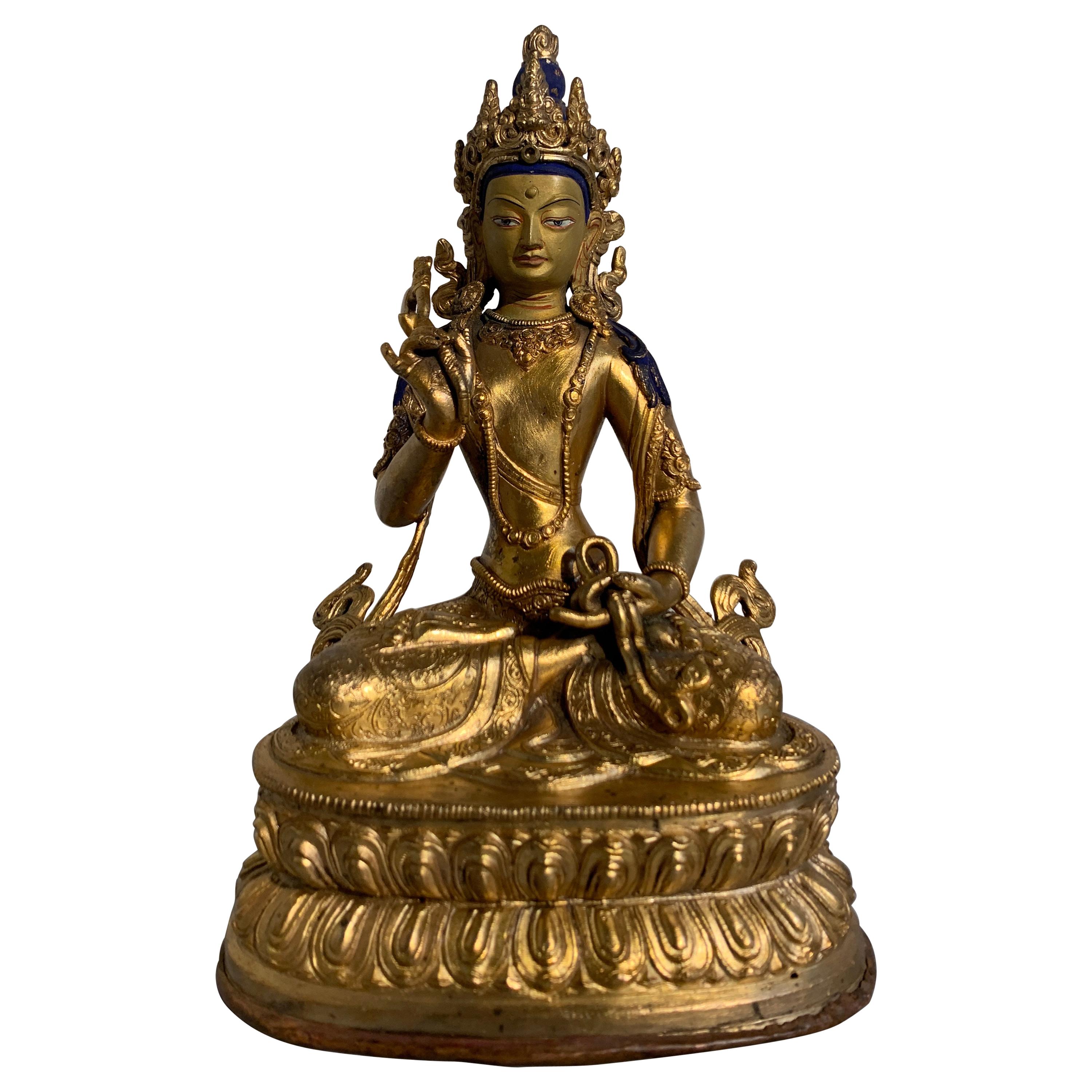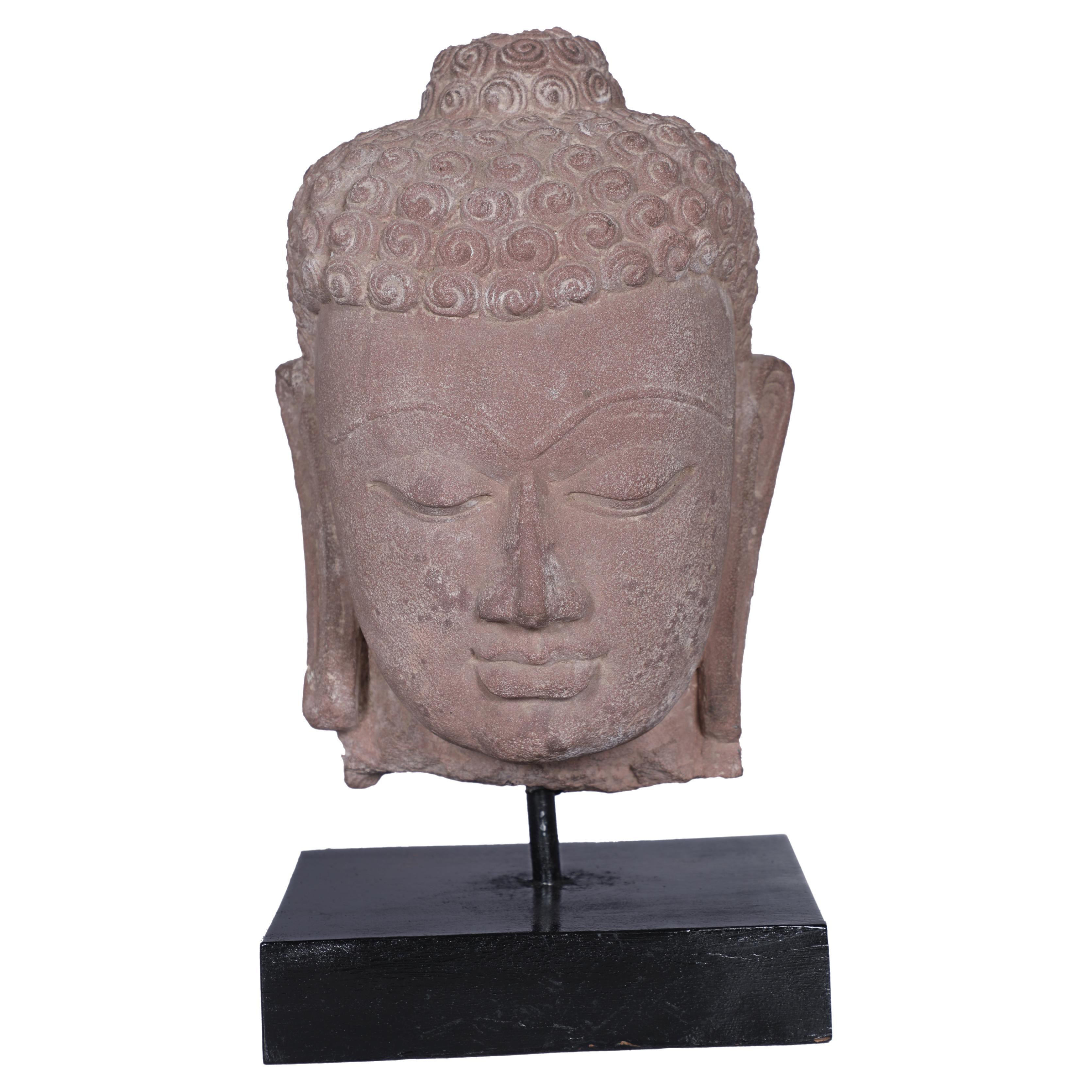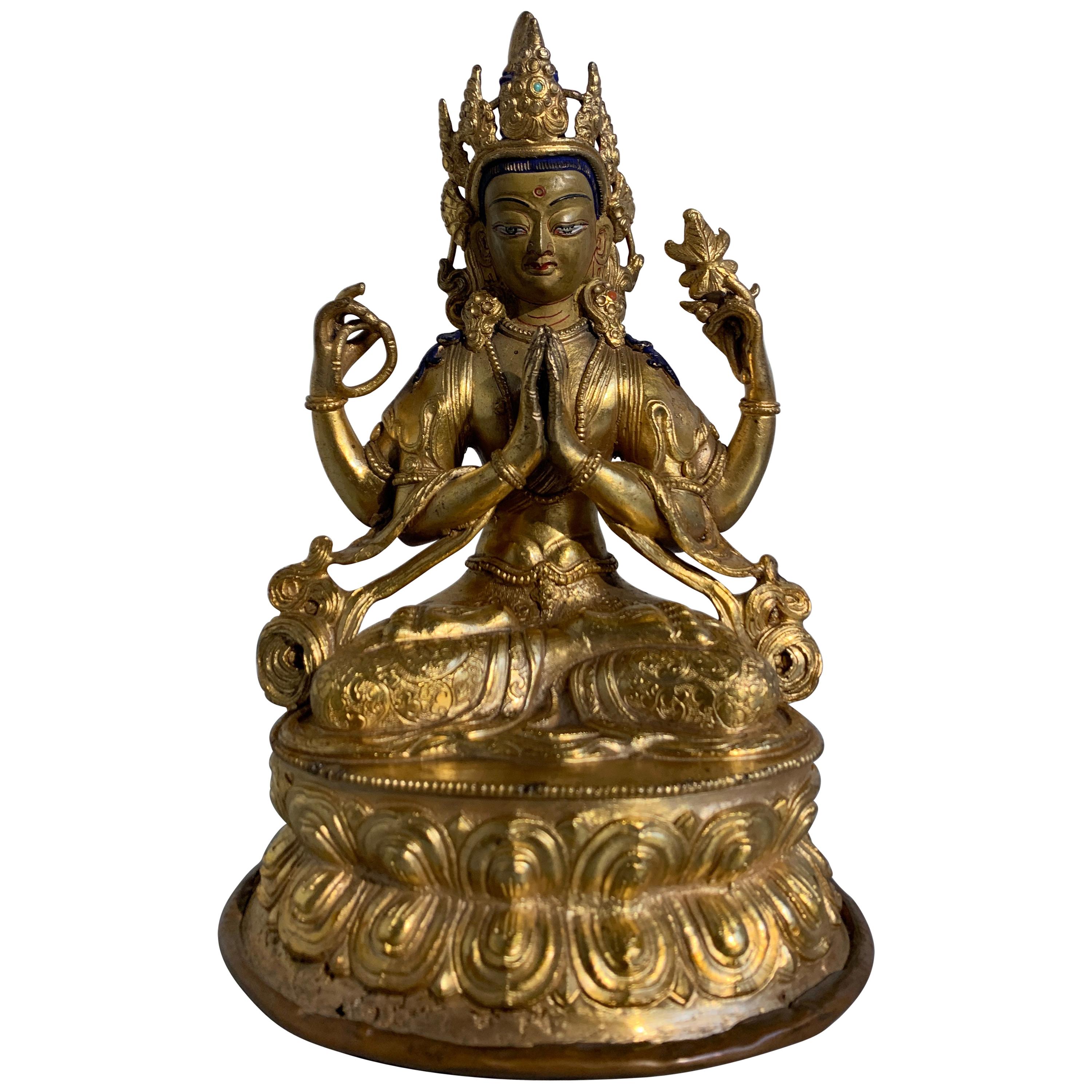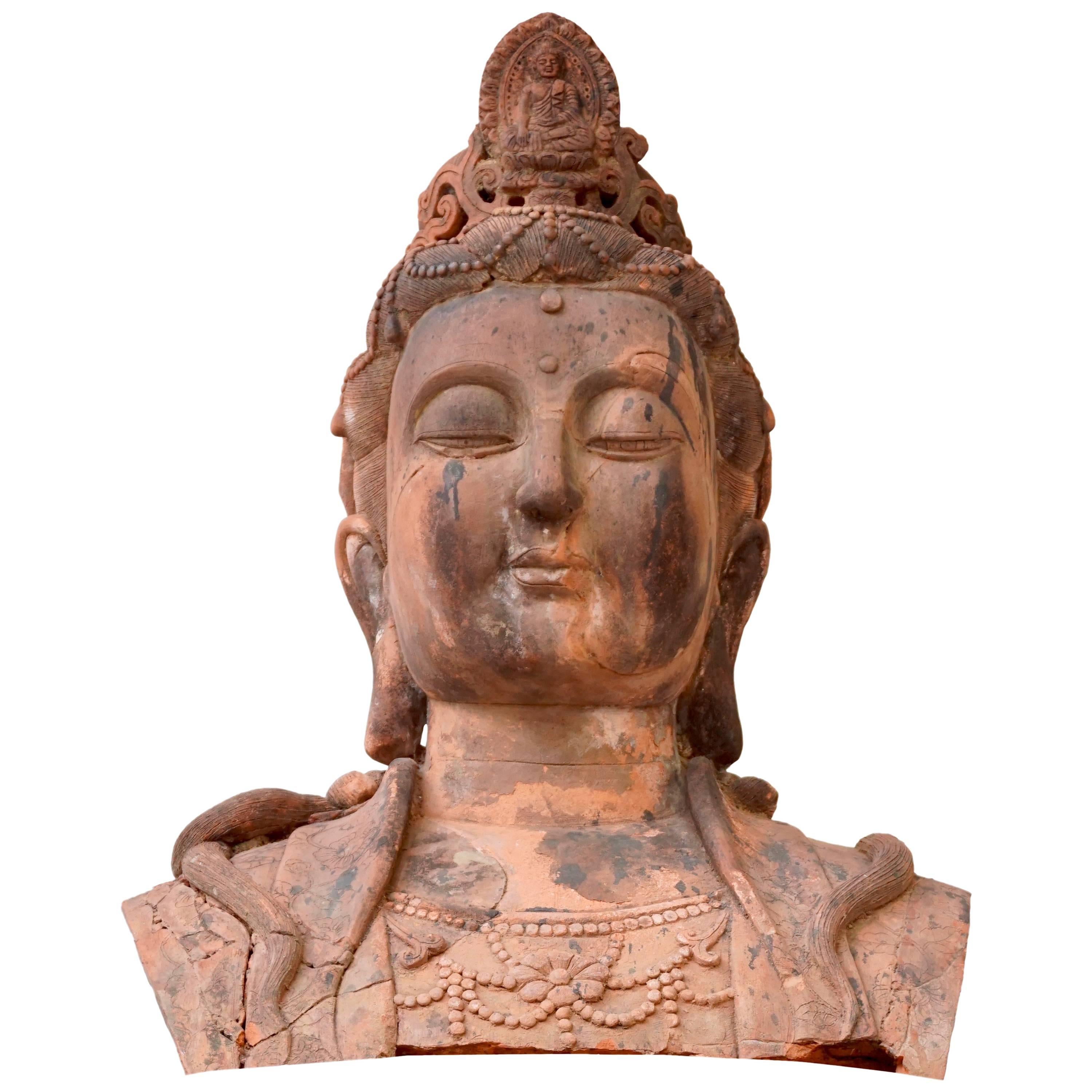Items Similar to Three Early 20th Century Red Horn Carvings of Buddha and Bodhisattva
Want more images or videos?
Request additional images or videos from the seller
1 of 15
Three Early 20th Century Red Horn Carvings of Buddha and Bodhisattva
About the Item
Three early 20th century red horn carvings of Buddha and Bodhisattvas. These three carvings all from approx. circa 1915 represent the bodhisattvas and or the Buddha. Carved from Ox horn with a deep red color the busts are then mounted on rosewood shoulders carved with the shape of robes closed and gathered creating totally articulated busts of the divinities. The carvings have great color and patina and show many years of devotion and care of handling as horn gets darker and deeper in color with the touching of hands and the oils in our skin yet still remain humble works of the decorative arts these busts are special devotion pieces.
- Dimensions:Height: 7 in (17.78 cm)Width: 4 in (10.16 cm)Depth: 3 in (7.62 cm)
- Materials and Techniques:
- Place of Origin:
- Period:
- Date of Manufacture:1915
- Condition:Wear consistent with age and use.
- Seller Location:Hudson, NY
- Reference Number:1stDibs: LU811316999622
About the Seller
4.7
Vetted Seller
These experienced sellers undergo a comprehensive evaluation by our team of in-house experts.
Established in 1978
1stDibs seller since 2005
Typical response time: 21 hours
- ShippingRetrieving quote...Ships From: Hudson, NY
- Return PolicyThis item cannot be returned.
More From This SellerView All
- Late 19th/Early 20th Century Carved Jade Mythical Bird CarvingLocated in Hudson, NYThis nicely carved bird figure is done in an 18th-century style but is from the very late 19th century to early republic period. The stone is a soft mellow celadon green with dark br...Category
Early 20th Century Chinese Sculptures
MaterialsJade
- Late 19th or Early 20th C. Carved Jade UrnLocated in Hudson, NYThis fine jade urn of a lovely spinach color running to a deep yellow is carved to resemble a pair of Buddhist lions or mythical beasts conjoined back to back...Category
Early 20th Century Chinese Urns
MaterialsJade
- Early 20th Century Chinese Qing Dynasty Large Jadeite Carved Plaque on StandLocated in Hudson, NYThis very nice carved plaque of good size comes from China and was made circa 1900. The stone is a rich combination of dark, light and emerald green. Sliced from a boulder washed and...Category
Early 20th Century Chinese Qing Sculptures and Carvings
MaterialsJade
- Pair of 20th Century Chinese Carved Bowenite Lidded Urns.Located in Hudson, NYThis nice pair of carved lidded urns are made form Bowenite which is considered a semiprecious stone and thought to resemble jade. They were carved in the mid 20th century and come w...Category
Mid-20th Century Chinese Sculptures and Carvings
MaterialsStone
- 19th Century Chinese Bronze Dancing FigureLocated in Hudson, NYThe charming figure done completely in the lost wax method is in a primitive naive style. The male figure is dancing excitedly on a rocky outcrop. His costume of a loose-fitting coat...Category
Antique 19th Century Chinese Sculptures
MaterialsBronze
- 19th Century Nephrite Jade Carved Plaque on StandLocated in Hudson, NYThis carved Nephrite Jade plaque of a mythical best has the attributes of a dragon and a fish leaping from the water. Carved we believe in the late 18th or early 19th century to be u...Category
Antique 19th Century Chinese Sculptures
MaterialsJade
You May Also Like
- Early 20th Century Pair of Chinese Wood Carving SculpturesLocated in North Miami, FLPresenting an exquisite pair of early 20th-century Chinese wood carvings that exude artistry and cultural richness. These masterfully crafted piece...Category
Early 20th Century Chinese Sculptures and Carvings
MaterialsWood
- Nepalese Gilt Bronze Bodhisattva 'Amoghapasha?', Early to Mid-20th CenturyLocated in Austin, TXA beautiful and unusual gilt bronze figure of a Bodhisattva, possibly Amoghapasha, Nepal, early to mid-20th century, circa 1930s or 1940s. The regal figure possibly depicting the bodhisattva Amoghapasha, the Unfailing Lasso. The enlightened being is portrayed seated upon a high double lotus pedestal. He is dressed as an Indian prince, wearing a luxurious foliate patterned dhoti around his waist and a billowing scarf around his shoulders. . His torso bare save for the jeweled necklaces and the sacred thread. A five pointed crown with an image of Amitabha Buddha in the central point graces his head. His princely face cold painted with beautiful detail, his hair colored blue with crushed lapis lazuli, indicating his peaceful nature. Amoghapasha holds a lasso in one hand, an axe in the other. He is considered an emanation of Avalokiteshvara. A bodhisattva of compassion, Amoghapasha is so named because of the lasso he holds in his hand. The lasso represents his vast compassion which is thought to extend to encompass all beings, bringing them into a state of perfection and enlightenment. The copper base plate, seemingly a later replacement, has been inscribed with a visvajra (double vajra...Category
Mid-20th Century Nepalese Tibetan Sculptures and Carvings
MaterialsLapis Lazuli, Bronze
- Early 20th Century Sandstone Buddha Head, Northern IndiaLocated in Nantucket, MAA lovely sandstone Buddha head on wooden base, early 1900's, Utttar Pradesh, Northern India. The hand-carved features include the typical snail-s...Category
Early 20th Century Asian Sculptures and Carvings
MaterialsSandstone
- Nepalese Gilt Bronze Figure of Bodhisattva Chenrezig, Mid-20th CenturyLocated in Austin, TXA nice vintage early to mid-20th century gilt bronze sculpture of the Buddhist deity Avalokiteshvara in his four armed form, known as Chaturbuhja, or Chenrezig in Tibet. Chenrezig, a form of Avalokiteshvara, the bodhisattva of compassion (known as Guan Yin or Kwan Yin in Chinese), sits in vajrasana upon a high double lotus pedestal. One pair of hands is clasped in prayer at heart level, the other pair of hands raised upwards at shoulder lever and holding discreet attributes, a mala (prayer beads) in one hand, a lotus blossom in the other. Chenrezig is dressed in an elaborately patterned floral dhoti that covers his lower half. His torso bare, shoulders covered with a shawl and scarves that billow out around him. He is festooned with jewels, necklaces, bracelets, armlets, earrings, belt and a five pointed crown. The earrings studded with coral. The crown studded with turquoise. His face is cold painted with beautiful details. The hair has been pigmented blue with crushed lapis, indicating his peaceful nature. The copper base plate is inscribed with a visvajra (double vajra...Category
Late 20th Century Nepalese Tibetan Sculptures and Carvings
MaterialsCoral, Lapis Lazuli, Bronze
- Larger Than Life Terracotta Buddha Bust of Guanyin, Early 20th Century, ChinaLocated in Antwerp, BEA massive larger than life terracotta buddha bust of Guan Yin, China, early 20th century. Broken and restored with wear and tear from enduring exposure to the elements. Size: 75 cm high. Weight: 40 kg. Guanyin, Kwanyin, Guanshiyin or Guanyin Pusa is the Chinese interpretation of the bodhisattva Avalokiteśvara (the goddess of comfort and mercy). In addition, she is seen in Taoism as an immortal. The scripture dedicated to her is Dabeizhou. Guanyin is the goddess of compassion and the sea. She is one of the three saints of the western paradise, along with Mahasthamaprapta and Amitabha Buddha; they are worshiped to save departed loved ones from hell and grant them entrance to the western paradise. Guanyin Chinese name Traditional Chinese 觀音 Simplified Chinese 观音 Transcriptions Full Chinese name Traditional Chinese 觀世音 Simplified Chinese 观世音 Literal meaning "[The One Who] Perceives the Sounds of the World" Transcriptions Second alternative Chinese name Traditional Chinese 觀自在 Simplified Chinese 观自在 Literal meaning "Lord who Gazes down on the World" Transcriptions Burmese name Burmese ကွမ်ယင် IPA [kwàɴ jɪ̀ɴ] Tibetan name Tibetan སྤྱན་རས་གཟིགས Vietnamese name Vietnamese alphabet Quan Âm (Quán Âm) Quán Thế Âm (Quan Thế Âm) Quán Tự Tại Chữ Hán 觀音 觀世音 觀自在 Thai name Thai กวนอิม, พระอวโลกิเตศวรโพธิสัตว์ RTGS Kuan Im, Phra Avalokitesuan Korean name Hangul 관음, 관세음, 관자재 Hanja 觀音, 觀世音, 觀自在 Transcriptions Mongolian name Mongolian script ᠨᠢᠳᠦ ᠪᠡᠷ ᠦᠵᠡᠭᠴᠢ Japanese name Kanji 観音, 観世音, 観自在 Hiragana かんのん, かんぜおん, かんじざい Transcriptions Indonesian name Indonesian Kwan Im, Kwan She Im, Awalokiteswara Filipino name Tagalog Guanyin (ᜄᜓᜀᜈᜌᜒᜈ) Sanskrit name Sanskrit अवलोकितेश्वर (Avalokiteśvara) Khmer name Khmer អវលោកិតេស្វរៈ (Avalokitesvarak), អវលោកេស្វរៈ (Avalokesvarak), លោកេស្វរៈ (Lokesvarak) Hmong name Hmong Kabyeeb, Niam-Txiv Kabyeeb, Dabpog, Niam-Txiv Dabpog Guanyin (traditional Chinese: 觀音; simplified Chinese: 观音; pinyin: Guānyīn) is a Bodhisattva associated with compassion. She is the East Asian representation of Avalokiteśvara (Sanskrit: अवलोकितेश्वर) and has been adopted by other Eastern religions, including Chinese folk religion.[note 1] She was first given the appellation "Goddess of Mercy" or "Mercy Goddess" by Jesuit missionaries in China.[1] Guanyin is short for Guanshiyin, which means "[The One Who] Perceives the Sounds of the World."[2] On the 19th day of the sixth lunar month, Guanyin's attainment of Buddhahood is celebrated.[3] Some Buddhists believe that when one of their adherents departs from this world, they are placed by Guanyin in the heart of a lotus, and then sent to the western pure land of Sukhāvatī.[4] Guanyin is often referred to as the "most widely beloved Buddhist Divinity"[5] with miraculous powers to assist all those who pray to her, as is mentioned in the Pumen chapter of Lotus Sutra and Kāraṇḍavyūha Sūtra. Several large temples in East Asia are dedicated to Guanyin, including Shaolin Monastery, Longxing Temple, Puning Temple, Nanhai Guanyin Temple, Dharma Drum Mountain, Kwan Im Thong Hood Cho Temple, Shitennō-ji, Sensō-ji, Kiyomizu-dera, Sanjūsangen-dō, and many others. Guanyin's abode and bodhimaṇḍa in India is recorded as being on Mount Potalaka. With the localization of the belief in Guanyin, each area adopted their own Potalaka. In Chinese Buddhism, Mount Putuo is considered the bodhimaṇḍa of Guanyin. Naksansa is considered to be the Potalaka of Guanyin in Korea. Japan's Potalaka is located at Fudarakusan-ji. Tibet's Potalaka is the Potala Palace. Vietnam's Potalaka is the Hương Temple. There are several pilgrimage centers for Guanyin in East Asia. Putuoshan is the main pilgrimage site in China. There is a 33 temple Guanyin pilgrimage in Korea which includes Naksansa. In Japan, there are several pilgrimages associated with Guanyin. The oldest one of them is the Saigoku Kannon Pilgrimage, a pilgrimage through 33 temples with Guanyin shrines. Guanyin is beloved by most Buddhist traditions in a nondenominational way and found in most Tibetan temples under the name Chenrézik (Wylie: Spyan ras gzigs). Guanyin is also beloved and worshipped in the temples in Nepal. The Hiranya Varna Mahavihar located in Patan is one example. Guanyin is also found in some influential Theravada temples such as Gangaramaya Temple, Kelaniya and Natha Devale nearby Temple of the Tooth...Category
Early 20th Century Chinese Chinese Export Sculptures and Carvings
MaterialsTerracotta
- Chinese Soapstone Fish Carving 20th CenturyLocated in Islamabad, PKChinese Soapstone fish carving 20th century. This exquisite soapstone sculpture is a unique carving, as it shows to us the natural formation of two stones with the grey soapstone accompanied by the red, yellow and beige soapstone carved into a beautiful depiction of fish and and underwater coral. Shoushan stone...Category
20th Century Chinese Ming Figurative Sculptures
MaterialsSoapstone
Recently Viewed
View AllMore Ways To Browse
Antique Red Color
Antique Carved Horn
Horn Handle
Red Horn
With Horn Handle
Articulated Sculpture
Red Robe
Carved Articulated
Buddha Patina
Red Buddha
Chinese Hand Carved Rosewood
Antique Bust Decorative Arts
Circa 20th Century Buddha
Chinese Horn
Bodhisattva Chinese
Chinese Ox
Carved Rosewood Sculpture
Ox Sculpture
